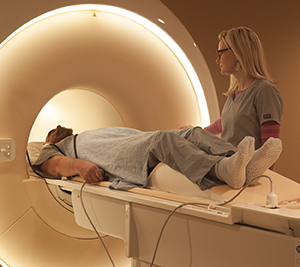What are some diagnostic tests for nervous system disorders?
Evaluating and diagnosing damage to the nervous system is complicated and complex. Many of the same symptoms happen in different combinations among the different disorders. Many disorders also don't have definitive causes, markers, or tests. That can make a diagnosis even harder.
To diagnose a nervous system disorder, a healthcare provider starts with a complete medical history and physical exam. They may also use one or more of these tests:
-
CT scan. This imaging test uses a combination of X-rays and computer technology to create detailed images of any part of the body, including bones, muscles, fat, and organs. CT scans are more detailed than general X-rays. They are used to diagnose disorders of the brain, spine, or other parts of the nervous system.
-
Electroencephalogram (EEG). This test records the brain's continuous electrical activity through electrodes attached to the scalp.
-
MRI. This test uses a combination of large magnets, radio waves, and a computer to make detailed images of organs and structures within the body. MRI creates images with much more detail than CT scan without radiation.
-
Electrodiagnostic tests, such as electromyography (EMG) and nerve conduction velocity (NCV). These tests evaluate and diagnose disorders of the muscles and motor neurons. Electrodes are inserted into the muscle or placed on the skin overlying a muscle or muscle group. Electrical activity and muscle response are recorded.
-
Positron emission tomography (PET). This test uses a small amount of radioactive material, a camera, and a computer to see how well organs and tissues are working. This test may see the early onset of disease before imaging tests can.
-
Arteriogram (angiogram). This X-ray of the arteries and veins detects blockage or narrowing of the blood vessels.
-
Spinal tap (lumbar puncture). During this test, a special needle is placed into the lower back, into the spinal canal. This is the area around the spinal cord and nerves. The pressure in the spinal canal and brain can then be measured. A small amount of cerebrospinal fluid (CSF) can be removed and sent for testing to find out if there is an infection or other problems. CSF is the fluid that bathes the brain and spinal cord.
-
Evoked potentials. This test records the brain's electrical response to visual, auditory, and sensory stimuli.
-
Myelogram. This test uses dye injected into the spinal canal to make the structure clearly visible on X-rays. This test is used less commonly because MRI is widely available.
-
Neurosonography. This test uses ultra-high-frequency sound waves. It allows the healthcare provider to analyze blood flow in cases of possible stroke. This includes carotid ultrasound and transcranial doppler.
-
Ultrasound (sonography). This imaging test uses high-frequency sound waves and a computer to make images of blood vessels, tissues, and organs. Ultrasounds are used to view internal organs as they function. They also assess blood flow through various vessels.


